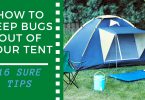We may receive commissions when you buy through the links on our site. Full Disclaimer.
Are you thinking of going camping soon? That sounds like fun. Camping is fun; you know, just staying in the great outdoors, enjoying nature, and doing away with the complexities of modern society.
Camping experiences can be quite relaxing. What intensifies the fun in camping is the fact that you will be doing away with the comforts you’re used to – relying on improvisations. But the challenge comes in making the perfect packing list for camping in a tent.
When packing for your camping trip in a tent, you must have a list of some essentials, so that you can get the best out of it. These essentials are compulsory things, and missing any of them could alter your experience of the whole trip. The list could include lots of other things depending on factors like;
- how long you intend to spend.
- how many people are going,
- age of the participants,
- campsite location.
But certain things remain integral to the success of the journey. So without much ado, let’s head into the packing list for camping in a tent successfully.
The Ultimate Tent Camping Checklist In 2021
1. Tent Footprint For Extra Ground Protection
The tent footprint is a vital thing to take along when planning to camp in a tent. Although it’s likely to be overlooked, tent footprints go a long way to give your tent extra protection. Depending on the terrain you decided to set up your tent, a footprint can help protect the base of the tent against elements such as sand, or sharp or thorny grass. It will also be helpful against conditions like murky ground.
The footprint is usually waterproof, although the bottom of the tent is likely waterproof too, there’s no harm in extra protection. It also makes the tent’s base (which may likely to get dirty) neater, and also to prevent the fast wearing-out of the tent. Ideally, you place one inside and out.
To get the best tent footprint, you have to measure the base of your tent to avoid getting one that is too small or too wide. Perhaps, your tent manufacturer would also have produced exact footprints for your tent, and you can purchase those together.
2. Stakes to Keep Everything in Place

Stakes, or pegs, are devices that help keep the tent in place. Think of them as big nails that hold the tent in position. Although they may appear in various shapes, sizes, and forms, they are designed to serve the same purpose which is securing the tent and protecting it from hefty winds.
These stakes are driven, either directly through the specially made holes in the tent, or they are secured by ropes. The type of stake to use depends on the size of the tent, and the terrain on which it would be placed, and these stakes, which are made of different materials, are modified to fit tight on specific grounds.
3. Sleeping Bags to Crash-In

Another essential item to add to your list is sleeping bags. You see, here in the open, we don’t use beds. No. That’s the luxury meant for your homes, besides it won’t fit in a tent. Here, we make do of sleeping bags, which are big bags like encasement to spend nights in.
The structures of these bags are usually thick, and properly insulated, and are meant to cover every part of the sleeper, leaving the head open, as that can be closed if the sleeper wants. That provides warmth and protects from bugs and other creatures that can hinder a good night’s rest.
Like anything else, these sleeping bags come in many forms and materials, but they stay true to their original design, providing as much safety and warmth, as much as possible. The beauty of this is that, unlike beds at home, sleeping bags can be set anyhow, as long as there is enough space to set your legs. So do make sure to add it to your list.
4. Sleeping Pad for Comfort

A sleeping pad is an alternative to the mattress at home. It seems like the best option for most, especially when there are two or more campers, or if you’re the type who doesn’t fancy being squeezed up in a bag. A sleeping pad provides the insulation and warmth you need while in the open and also provides cushioning, which makes it better than directly sleeping on the tent floor.
These pads come in various forms, with those you inflate by yourself, which we call air pads and those which are self-inflating and are more convenient. A very significant thing to check for is that the pad is just as comfy as you’d want it to be. But don’t be deceived, as the pad can never come to be as comfortable as the mattress in your room, still, it’s better than the bare footprint.
5. Camping Chairs for Extra Comfort

Of course, we don’t use plush couches here too; No sofas or soft armchairs. Out here in the outdoors, we make use of rugged camping chairs, which can make for good sitting, after a long hike, or climb, or any other exercise in the open.
Certain things have to be considered, as usual, such as the size, and weight of the chair, but it’s best to go for one that is durable. Also, ensure you check if the chair provides neck and/or back support. Be sure to choose one that fits your needs, and make it a must to get it.
6. Lights to Help Cope In the dark.

The sensation of a camping trip is best felt at night. That is when you hear the chirping of the insects and other nocturnal animals. However, it is still vital that you get to see your way, and the moonlight and stars aren’t enough, especially when it’s that time of the month when the moon is under a cloud. Whatever the case may be, it is essential you pack along with some light, as tents are appropriately devoid of electrical modifications for bulbs and the rest.
You may have to make do with electric torches. These, although it poses a problem of charging, which should be less threatening if you’re only spending a night or two in the woods. Also, today, there are lots of solar torches that charge with the help of the sun. You place them out in the open during the day, and they get all the juice they need to last all night. Better still, you can opt for the torches that use batteries. Just be sure to take a good supply of cells.
Another alternative is to make do with lanterns. Lanterns provide the best outdoor experience, as everything seems so natural, including the lights. Just be sure to manage it properly so it doesn’t come in contact with something that can lead to a fire.
Whichever option you settled for, do add it to the list as it’s almost impossible to go camping without having any form of light.
7. Cooking Utensils Are Very Necessary

You have to cook while camping. It’s impossible not to if you’ve decided to spend a long time. And there’s no way to easily improvise the things you have in the kitchen unless you’re a hardcore survivalist. So, it’s best to take along your cooking utensils.
If nothing else, try to pack a pot and a kettle at least. The pot is to help with basic cooking, while the kettle can be used to boil water. This pot doesn’t have to be massive; just something adequate to hold your food. You may also pack a frying pan if you’re into frying a lot.
Note that you most likely will cook over a fire directly, so be sure of how to place the pots and pans on top of the campfire easily. Or you may have to pack a camping stove along with you, just for convenience’s sake. And for that, be certain to carry along some cooking fuel.
8. Eating utensils
Also, a must-have, especially when you’re quite a number. Even if you’re alone, there is a need for you to make use of plates, spoons, forks, etc. So you must add them to your camping list as forgetting that may cause enormous discomfort, and may even make you end your camping trip sooner than planned. Remember what they say – it’s the tiny things that count. So, please pay attention to the details.
9. Toiletries for Good Hygiene
Be sure to pack some basic toiletries while going on a trip. Because you are going to be around animals doesn’t mean you have to be like them. Staying out in the woods shouldn’t stop you from taking your bath, looking fresh or disposing of your body waste properly.
You should take along soaps, especially the ones which are biodegradable so that they can have a positive effect on the surroundings. Of course, you don’t want to forget your toothbrush and toothpaste. You may also pack shaving sticks too. Hand sanitizers, toilet tissues, shampoos are among the list of things you can add under this list.
The whole point is to be neat and fresh while out in the woods. It doesn’t dampen the effect.
10. A First Aid Kit In Case of Emergency
The importance of a first aid kit cannot be overemphasized. You need to carry one along, as you never can tell what can happen while on a camping trip.
The package should contain basic things like a bandage; in the eventuality of a wound which is not impossible while out in the woods. It should also contain methylated spirits, aspirin, simple medicines for stomach upsets, cod liver oil, ointments, plaster, healing balm, among others.
You may decide to pack this by yourself, or you can buy a first aid box, which should contain all of these things, and even more. For the sake of ease, I recommend purchasing the Swiss Safe 2-in-1 First Aid Kit on Amazon. You can click on the picture below to get one right away. It contained more than 35 crucial first aid contents.

You never can tell what might happen, and being equipped with this box might help save a situation or even a life.
11. Tent Repair Kit
There is every possibility that your sweet tent might get ruined through some force beyond your control. Situations like this may be due to harsh winds, or torrential rain, or anything. You might experience a hole or two or some part that needs straightening out. That’s why it’s crucial to have a tent repair kit so you can quickly take care of problems as soon as they appear.
Other Necessary Things for Camping
You should also remember to take things like a knife (and a file), or you might make do with a set of Swiss Army knives, a gaslighter, a box of match sticks, some firewood (although you may readily find this in the wild).
You may also be the want to pack along a solar charger, in case you can’t bear being cut out from the rest of the world while camping, a radio set, a satellite phone (if you have one or can afford it). If you are camping in a group, you may need a set of walkie talkies to keep in touch with yourselves.
Again, there may be a need for a water filter or purifier, to make the water you find safe for drinking. You may also need to take bug repellents, to keep insects at bay.
Last Words
The number of things you can include in your packing list for camping in a tent depends on your means of getting to the campsite. You’re most likely going to carry more items if you’re going in a car or a truck, than if you’re backpacking.
Still, it is necessary to keep in mind to carry along some of these gears as they make the difference between camping and getting stranded in the woods. Just be sure to follow this list as much as you can to get the best out of the next trip.




